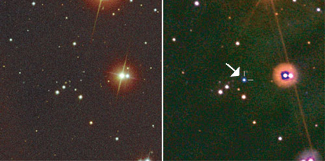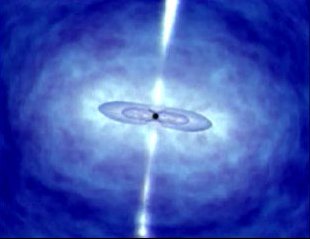Spotlight on an Exploding Star
A sudden burst of radiation has drawn astronomers to the early stages of a star explosion.
Share this:
- Share via email (Opens in new window) Email
- Click to share on Facebook (Opens in new window) Facebook
- Click to share on X (Opens in new window) X
- Click to share on Pinterest (Opens in new window) Pinterest
- Click to share on Reddit (Opens in new window) Reddit
- Share to Google Classroom (Opens in new window) Google Classroom
- Click to print (Opens in new window) Print
By Emily Sohn
The catastrophic collapse of a star is attracting a lot of attention right now.
Astronomers were drawn to the distant explosion by a gamma-ray burst—radiation of extremely high energy. They then detected the fiery glow of the exploding star, or supernova, that generated the burst. The glow was so bright that it outshone the entire galaxy that hosts the star.
 | ||
|
| ||
| SDSS (left), NASA/Swift/UVOT (right) |
As a star collapses and explodes at the end of its life, it spits out jets of material that can move almost as fast as the speed of light. As chunks of material collide, they produce gamma rays.
Gamma-ray bursts can be seen over extremely long distances—billions of light-years. The visible light that comes from a supernova, however, can be observed only if the star is relatively close to Earth. The newly detected supernova is 440 million light-years from Earth, and it appears in the sky in the constellation Aries.
The gamma-ray burst, called GRB 060218, lasted almost 2,000 seconds, which is about 100 times as long as a typical burst. As soon as the satellite detected it, astronomers began racing to locate the supernova that went with it.
Researchers from the California Institute of Technology in Pasadena found it on Feb. 21, using the large Gemini South Observatory on Cerro Pachón Mountain in Chile.
The supernova should be at its brightest on March 5. With a telescope at least 16 inches across, anyone in the Northern Hemisphere should be able to see it.
 |
|
The gamma-ray burst detected by the Swift spacecraft may have been caused by a collapsing star. This illustration shows the center of a dying star collapsing just minutes before the star implodes and emits a gamma-ray burst.
|
| NASA/Dana Berry |
Every supernova becomes either a black hole or a magnetar, an extremely dense, rapidly spinning star with an enormous magnetic field. Black holes are so dense that they swallow anything that comes near them, including light.—E. Sohn
Going Deeper:
Cowen, Ron. 2006. Unique explosion: Gamma-ray burst leads astronomers to supernova. Science News 169(March 4):133-134. Available at http://www.sciencenews.org/articles/20060304/fob6.asp .
News of the recent gamma-ray burst and supernova can be found at swift.gsfc.nasa.gov/docs/swift/news/2006/06-18.html (NASA) and www.science.psu.edu/alert/Nousek2-2006.htm (Pennsylvania State University).
You can learn more about the Swift satellite at swift.gsfc.nasa.gov/docs/swift/swiftsc.html and www.nasa.gov/vision/universe/watchtheskies/swift_first_light.html (NASA).
Information about supernovas can be found at imagine.gsfc.nasa.gov/docs/science/know_l2/supernovae.html and heasarc.gsfc.nasa.gov/docs/snr.html (NASA Goddard Space Flight Center).
Sohn, Emily. 2005. Black hole journey. Science News for Kids (Feb. 2). Available at http://www.sciencenewsforkids.org/articles/20050202/Feature1.asp .






